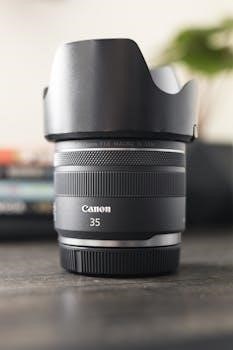Zoom H6 Manual Zoom⁚ An Overview
The Zoom H6 is a versatile portable recorder that captures audio with high fidelity. It’s designed for various recording scenarios, offering multi-track capability and interchangeable microphone options. Its user-friendly design makes it accessible for both beginners and experienced users.
The Zoom H6 is a highly adaptable handheld audio recorder, renowned for its multi-track recording and interchangeable microphone system. This device is a favorite among musicians, filmmakers, and podcasters due to its versatility and robust feature set. The H6 allows for capturing up to six simultaneous tracks, accommodating a wide range of recording needs, from simple voice memos to complex musical performances. Its modular design supports different microphone capsules, enabling users to tailor the recorder to specific acoustic environments. The Zoom H6 is well-suited for on-location recording, studio work, and live events, combining professional audio quality with user-friendly operation. The device is powered via batteries or a USB connection, which also allows it to function as a multi-channel audio interface. It’s compact and portable, making it a great choice for recording both in controlled environments and on the move. Its intuitive interface and clear display simplify the recording process, ensuring that users can focus on capturing their audio.
Key Features of the Zoom H6
The Zoom H6 boasts a range of impressive features that make it a standout audio recorder. Its interchangeable microphone system is a core strength, allowing users to switch between X/Y, Mid-Side, and shotgun capsules. The device offers six input channels, enabling simultaneous recording of multiple audio sources. The H6 supports up to 24-bit/96kHz audio resolution, ensuring high-quality recordings with exceptional clarity. It features built-in preamps with phantom power, accommodating both dynamic and condenser microphones. The H6 functions as a 6-in/2-out USB audio interface, facilitating seamless integration with computers. Its color LCD screen provides clear visual feedback during recording sessions. The H6 supports SD cards for expandable storage, allowing for prolonged recording times. The device also has a built-in tuner and metronome, making it a valuable tool for musicians. Drop tuning options are available for various tuner types. The H6 can be powered by batteries, USB or an optional AC adapter, offering flexibility for different recording scenarios. These key features make the Zoom H6 a very versatile and powerful tool.

Multi-Track Recording Capabilities
The Zoom H6 excels in multi-track recording, allowing users to capture up to six separate audio tracks simultaneously. This feature is crucial for recording complex audio setups, such as live bands, podcasts with multiple participants, or film shoots requiring various microphone inputs. Each input channel is recorded to an individual audio file, providing maximum flexibility during the post-production process. This multi-track functionality enables users to independently adjust levels, apply effects, and perform mixing on each track separately, thereby creating a professional and refined final product. The H6 allows for the use of various microphone configurations, including the built-in XY mic and external microphones, all being recorded as discrete tracks. This capability allows for the capture of a stereo image alongside individual vocal or instrument tracks. The multi-track recording function is essential for users needing full control over their audio during production. With the Zoom H6, users can easily capture multi-layered recordings and create dynamic and textured soundscapes. The separate tracks provide a wide range of options during the mixing process.
Understanding Track Creation and Mixdowns
When recording with the Zoom H6, each microphone input creates a separate audio file, which is referred to as a track. This process is fundamental to multi-track recording. These tracks are stored individually, allowing for independent manipulation and adjustment during editing and mixing. To listen to all the recorded tracks together, a mixdown is necessary. This mixdown process combines the separate tracks into a single stereo or multi-channel audio file, enabling a holistic listening experience. The mixdown is essential for creating a final version of the audio, suitable for playback or further post-processing. The Zoom H6 simplifies this by providing tools to create a mixdown directly within the recorder. Understanding how tracks are created and the necessity of mixdowns is crucial for effectively using the H6. The mixdown process allows the user to blend the individual tracks into a cohesive audio output, thereby creating a polished final product. Users can fine-tune the mix levels and apply basic effects to each track during the mixdown process, if needed. This function provides a practical approach to audio management.

Zoom H6 Operation and Functionality
The Zoom H6 can function as a versatile audio interface via USB. It offers 2-in/2-out or 6-in/2-out options, expanding its utility beyond a standalone recorder for various recording scenarios.
Using the Zoom H6 as an Audio Interface
The Zoom H6’s functionality extends beyond a simple handheld recorder; it can seamlessly transition into a robust audio interface when connected to a computer via USB. This capability allows users to record directly into their preferred digital audio workstation (DAW), effectively transforming the H6 into a multi-channel input device. It offers flexibility with two distinct operational modes⁚ a 2-input/2-output mode, ideal for simpler setups, and a more comprehensive 6-input/2-output mode, catering to complex recording sessions. This dual functionality makes the H6 a valuable asset for both on-location recording and studio work. The audio interface feature enables the recording of multiple audio sources simultaneously, allowing for meticulous mixing and editing within a DAW. Furthermore, the direct digital connection ensures pristine audio quality, minimizing any potential signal degradation often associated with analog audio paths. The ability to monitor recordings in real-time, either through headphones or studio monitors, further enhances the H6’s versatility as an audio interface. This integration into a digital workflow streamlines the recording process, allowing users to focus on capturing the desired audio without the limitations of standalone recording. The Zoom H6’s flexibility, as an interface, makes it an indispensable tool for any audio professional or enthusiast;
Tuner Functionality and Drop Tuning
The Zoom H6 incorporates a handy tuner functionality, a valuable tool for musicians and audio professionals alike. This integrated tuner assists in ensuring that instruments are perfectly in tune before recording, eliminating the need for external tuning devices. The tuner supports various tuning modes, catering to different types of instruments, though it’s worth noting that it may not include a chromatic mode. One of the particularly useful features of the tuner within the H6 is its capability for drop tuning. This allows musicians to quickly and easily adjust the pitch of their instrument down by up to three semitones, facilitating playing in lower keys or achieving specific sonic effects without physically altering the instrument’s tuning. The drop tuning feature is accessible through dedicated controls, making it simple to use while on the go or during live performances. The intuitive interface of the tuner ensures that users can quickly get their instruments in tune, saving time and allowing for a smoother recording process. Whether a standard tuning or a dropped tuning is needed, the Zoom H6 delivers reliable and accurate performance, making it a versatile companion for any music-related audio task. This functionality is a significant convenience for a broad range of musical applications.

Zoom H6 Technical Details
The Zoom H6 employs advanced A/D converters, switching between them to achieve optimal recording results. It supports 32-bit float WAV files, providing superior dynamic range compared to traditional 16/24-bit formats.
A/D Converter and 32-Bit Float Recording
The Zoom H6 utilizes sophisticated Analog-to-Digital (A/D) converters that constantly monitor input signals, dynamically selecting the optimal converter for the best recording outcome. This ensures high-quality audio capture across various recording environments. A key feature is its support for 32-bit float WAV files, which offer significant advantages over standard 16 or 24-bit formats. 32-bit float recording provides an exceptionally wide dynamic range, meaning it can capture both very quiet and very loud sounds without clipping or distortion. This is crucial for recording complex audio where the volume levels may fluctuate dramatically. The extra headroom afforded by 32-bit float eliminates the need to meticulously adjust gain levels during recording, offering more flexibility during the post-production stage. This capability makes the H6 a powerful tool for capturing pristine audio in diverse and challenging conditions, giving users more confidence when recording. The H6 can handle a wide range of recording levels, which is particularly useful in unpredictable recording situations.
Microphone Options and Interchangeability
A standout feature of the Zoom H6 is its versatile microphone system, which allows for various recording applications through interchangeable microphone capsules. The H6 comes standard with an XY microphone capsule, featuring newly developed 14.6mm large diaphragm mics that capture detailed stereo recordings. This capability allows the H6 to record a wide range of sounds, from subtle nuances to powerful audio signals. The microphone capsules are easily swapped, enabling users to adapt to different recording environments and needs. The H6 offers multiple microphone options that can be purchased separately, including Mid-Side (MS) configurations, shotgun microphones, and external input modules that provide additional XLR/TRS inputs, expanding the unit’s overall flexibility. This system provides users with various ways to capture audio, ensuring the best possible results. Each microphone capsule is designed to work harmoniously with the H6, offering consistent quality and performance. The interchangeability of these microphones enhances the recorder’s adaptability and makes it suitable for a wide range of scenarios, and allows users to tailor the device to their specific needs.

Zoom H6 Documentation and Support
The Zoom H6 operation manual and quick guides are available for download on the Zoom website, provided in PDF and ePub formats. These resources provide detailed instructions for users.
Accessing the Operation Manual and Quick Guides
The primary resource for understanding your Zoom H6 is the official operation manual, readily accessible on the Zoom website (www.zoom.co.jp/docs/h6). This comprehensive manual is available in both PDF and ePub formats, catering to various user preferences and devices. The PDF version is particularly suitable for printing and offline reference, while the ePub format is ideal for viewing on e-readers and tablets. Alongside the full manual, a quick guide is also provided, offering a condensed overview of the H6’s essential functions, perfect for on-the-go reference and rapid familiarization. These documents are crucial for unlocking the full potential of the Zoom H6, providing detailed explanations of its features, settings, and operational procedures. They cover topics ranging from basic recording to advanced multi-track techniques, ensuring users of all skill levels can benefit from the information provided. Regular consultation of these resources will help in troubleshooting issues and maximizing the H6’s performance in diverse recording scenarios.
Firmware Updates and Driver Installation
Maintaining your Zoom H6 with the latest firmware is essential for optimal performance and access to new features. Firmware updates can be easily downloaded from the official Zoom website (www.zoom.co.jp), ensuring your device is running the most stable and efficient software. These updates often include bug fixes, performance enhancements, and new functionalities. Along with firmware, installing the necessary drivers is crucial, especially when using the H6 as an audio interface with your computer. The required drivers are also available on the Zoom website, ensuring seamless connectivity and compatibility with your operating system; The driver installation process is generally straightforward, with detailed instructions provided by Zoom. Regular firmware updates and proper driver installation will ensure smooth operation, allow you to take advantage of all the capabilities of the H6, and prevent compatibility issues. These steps are vital for all users seeking a robust and reliable recording experience.
